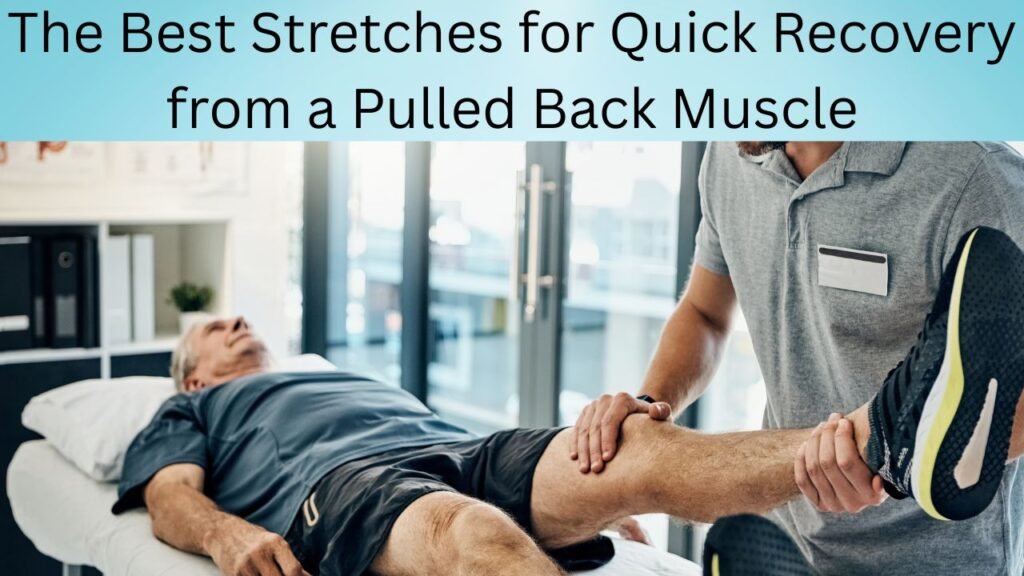A pulled back muscle can be painful and frustrating. Whether it happened from lifting something heavy or making a sudden movement, the discomfort can limit your mobility. The right stretches can speed up recovery by reducing stiffness, improving blood flow, and preventing further injury. Below are the most effective stretches to ease pain and restore movement in your back.

1. Cat-Cow Stretch
This gentle movement improves spinal flexibility and reduces tension in the lower back.
How to Do It:
- Get on your hands and knees, with wrists aligned under shoulders and knees under hips.
- Inhale, arch your back, and lift your head and tailbone (Cow Pose).
- Exhale, round your spine, tuck your chin, and pull your belly button in (Cat Pose).
- Repeat slowly for 1-2 minutes.
Why It Helps: This stretch increases mobility in the spine and relieves muscle tightness.
2. Child’s Pose Alternative (Extended Puppy Pose)
Since Child’s Pose may not be suitable for everyone with back pain, the Extended Puppy Pose is a great alternative.
How to Do It:
- Start on all fours and slowly extend your arms forward.
- Keep your hips high and chest close to the ground.
- Hold for 30 seconds to a minute, breathing deeply.
Why It Helps: This stretch lengthens the spine while gently relaxing tight back muscles.
3. Seated Forward Fold
A gentle way to stretch the lower back and hamstrings without excessive strain.
How to Do It:
- Sit on the floor with legs extended straight.
- Slowly bend forward from the hips, reaching toward your toes.
- Hold the stretch for 20-30 seconds.
Why It Helps: Tight hamstrings can worsen back pain. This stretch relieves tension from the lower back.
4. Knee-to-Chest Stretch
This is an effective stretch for relieving tension in the lower back and glutes.
How to Do It:
- Lie on your back with knees bent and feet flat on the floor.
- Bring one knee to your chest, holding it with both hands.
- Hold for 20-30 seconds, then switch sides.
Why It Helps: It gently decompresses the spine and relieves pressure on the lower back.
5. Piriformis Stretch (Seated Figure-Four Stretch)
Often, back pain originates from tight glutes or the piriformis muscle.
How to Do It:
- Sit on a chair and cross your right ankle over your left knee.
- Gently lean forward, keeping your back straight.
- Hold for 20-30 seconds, then switch sides.
Why It Helps: Loosens tight glute muscles, which reduces pressure on the lower back.
6. Supine Spinal Twist
This stretch improves spinal mobility and relieves tension in the back.
How to Do It:
- Lie on your back with knees bent and feet flat on the floor.
- Drop both knees to one side while keeping shoulders flat on the floor.
- Hold for 20-30 seconds, then switch sides.
Why It Helps: Twisting movements help release stiffness and promote better spinal alignment.
7. Standing Backbend Stretch
A simple way to counteract prolonged sitting and ease lower back tension.
How to Do It:
- Stand with feet hip-width apart.
- Place hands on your lower back for support.
- Slowly lean backward, looking up slightly.
- Hold for 10-15 seconds.
Why It Helps: It opens up the spine and relieves tightness caused by slouching or prolonged sitting.
8. Cobra Stretch (Gentle Version)
A mild back extension that helps restore mobility.
How to Do It:
- Lie on your stomach with hands under your shoulders.
- Slowly lift your chest, keeping elbows slightly bent.
- Hold for 10-20 seconds.
Why It Helps: Strengthens the lower back and improves spinal flexibility without straining the muscles.
Additional Tips for Faster Recovery
Besides stretching, here are key practices to help you recover quicker:
- Apply Heat or Ice: Ice helps reduce swelling initially, while heat relaxes stiff muscles.
- Stay Active: Light movement prevents stiffness. Avoid complete bed rest.
- Strengthen Core Muscles: A strong core supports the spine and prevents future injuries.
- Maintain Good Posture: Sitting upright reduces strain on your back.
- Hydrate and Eat Well: Proper nutrition aids muscle repair.
When to See a Doctor
If your pain worsens, persists for weeks, or radiates down your legs, consult a healthcare professional. Severe symptoms may indicate a more serious condition like a herniated disc or nerve compression.
Final Thoughts
Stretching plays a crucial role in recovering from a pulled back muscle. These gentle movements help reduce pain, improve flexibility, and prevent future injuries. By incorporating them into your routine, you can speed up healing and regain mobility. If pain persists, seek medical advice to ensure a safe recovery.